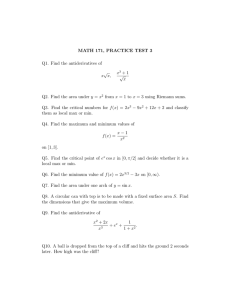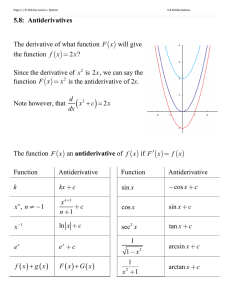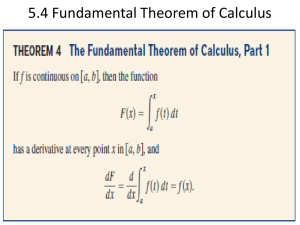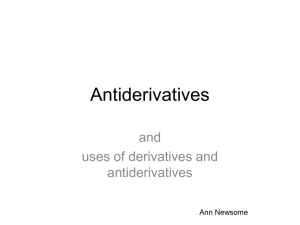Exam 3 Review
advertisement
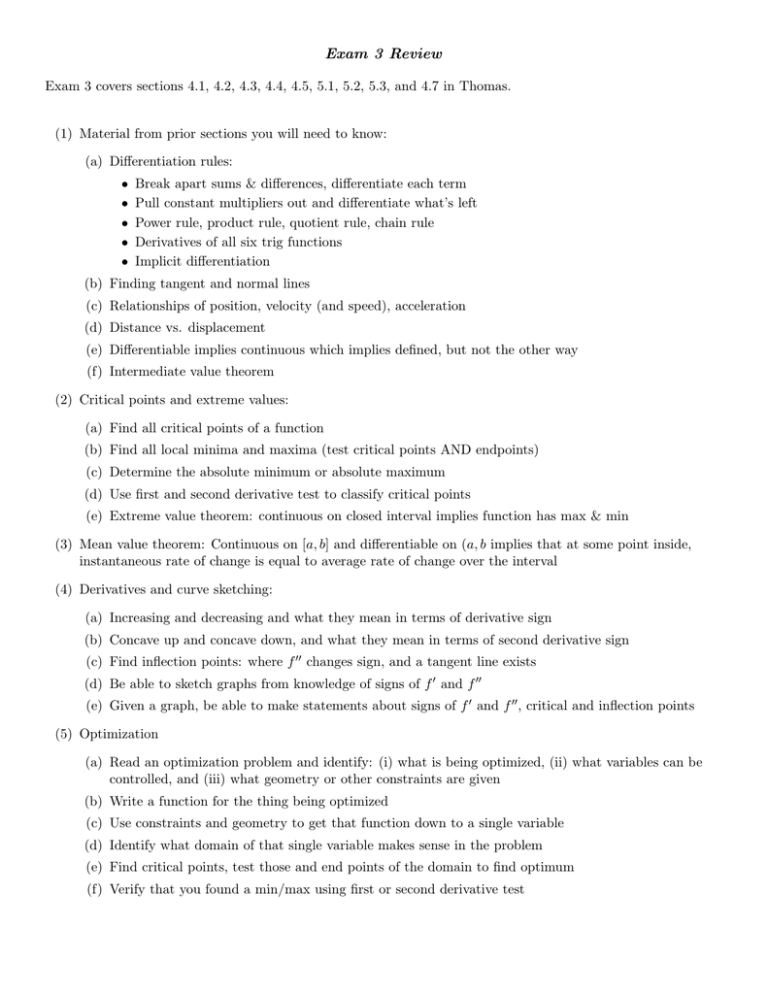
Exam 3 Review Exam 3 covers sections 4.1, 4.2, 4.3, 4.4, 4.5, 5.1, 5.2, 5.3, and 4.7 in Thomas. (1) Material from prior sections you will need to know: (a) Differentiation rules: • • • • • Break apart sums & differences, differentiate each term Pull constant multipliers out and differentiate what’s left Power rule, product rule, quotient rule, chain rule Derivatives of all six trig functions Implicit differentiation (b) Finding tangent and normal lines (c) Relationships of position, velocity (and speed), acceleration (d) Distance vs. displacement (e) Differentiable implies continuous which implies defined, but not the other way (f) Intermediate value theorem (2) Critical points and extreme values: (a) Find all critical points of a function (b) Find all local minima and maxima (test critical points AND endpoints) (c) Determine the absolute minimum or absolute maximum (d) Use first and second derivative test to classify critical points (e) Extreme value theorem: continuous on closed interval implies function has max & min (3) Mean value theorem: Continuous on [a, b] and differentiable on (a, b implies that at some point inside, instantaneous rate of change is equal to average rate of change over the interval (4) Derivatives and curve sketching: (a) Increasing and decreasing and what they mean in terms of derivative sign (b) Concave up and concave down, and what they mean in terms of second derivative sign (c) Find inflection points: where f 00 changes sign, and a tangent line exists (d) Be able to sketch graphs from knowledge of signs of f 0 and f 00 (e) Given a graph, be able to make statements about signs of f 0 and f 00 , critical and inflection points (5) Optimization (a) Read an optimization problem and identify: (i) what is being optimized, (ii) what variables can be controlled, and (iii) what geometry or other constraints are given (b) Write a function for the thing being optimized (c) Use constraints and geometry to get that function down to a single variable (d) Identify what domain of that single variable makes sense in the problem (e) Find critical points, test those and end points of the domain to find optimum (f) Verify that you found a min/max using first or second derivative test (6) Area Estimation (a) Given a function or graph, be able to give an estimate of the signed area between the graph and the x axis using a given (small) number of rectangles and either left endpoints, right endpoints, or midpoints (b) Understand the idea that in the limit as the widths of the rectangles used to estimate approaches zero, the estimate approaches the true area, but you will not need to evaluate such a limit (c) Understand when each method (left endpoints, right endpoints, midpoints) can underestimate or overestimate area) (d) Understand that no method is more accurate then another in every case, and that more rectangles is not always more accurate, but that all methods will eventually approach the same (true) area as the rectangle widths approache zero (e) Signed area under f 0 from a to b = change in f (x) over that interval = displacement (f) Total area under f 0 from a to b (counting area below axis as positive) = distance traveled (7) Sigma notation (a) Evaluate sums expressed in sigma notation by writing out terms and adding them up n X n(n + 1) (b) Know the simplest Gauss formula: k= . 2 k=1 (c) Given a list of terms, be able to write it in sigma notation (d) Be able to handle alternating signs with either (−1)k or (−1)k+1 (8) Definite integrals (a) Integral rules: • Continuous functions and those with any number of step discontinuities are integrable • Break apart sums & differences, integrate each term • Pull constant multipliers out and integrate what’s left Z c Z b Z c • f (x) dx = f (x) dx + f (x) dx a a b Z b Z a • f (x) dx = − f (x) dx a b Z a • f (x) dx = 0 a (b) Average value of a function is its integral divided by the width of the interval (9) Antiderivatives (a) Don’t forget the “+C” when finding a general antiderivative! (b) Antiderivative rules: • • • • Break apart sums & differences, find antiderivative of each term Pull constant multipliers out and find antiderivative of what’s left Antiderivatives of constants and powers of x Antiderivatives of sin, cos, sec2 , sec tan, csc2 , csc cot (c) Solve initial value problems - given f 00 as a function, and f 0 at some point, and f at some point, recover the function f
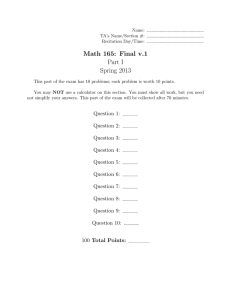
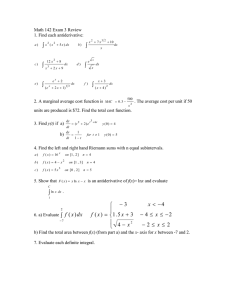
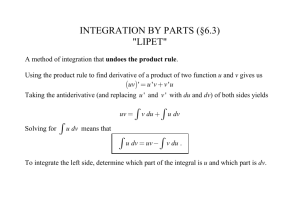
![Antiderivatives [7.5]](http://s2.studylib.net/store/data/009839726_1-71c8c3c8e7789734542b65fee1d9e6d4-300x300.png)
